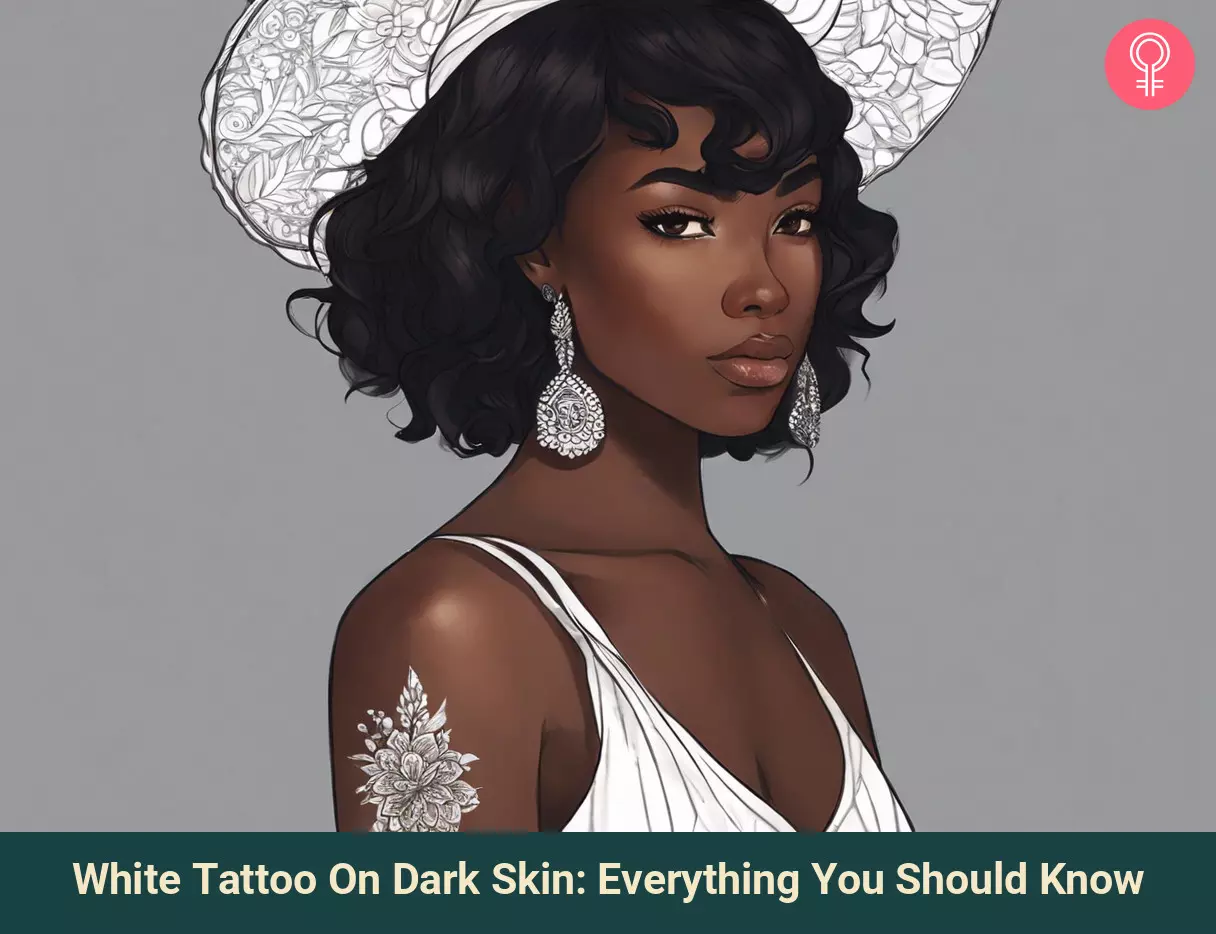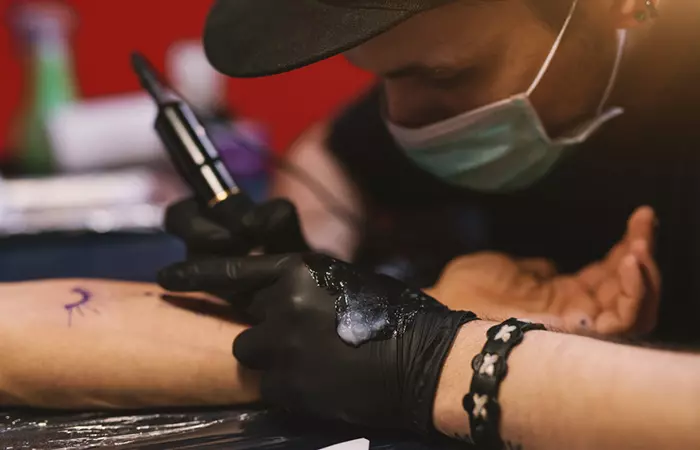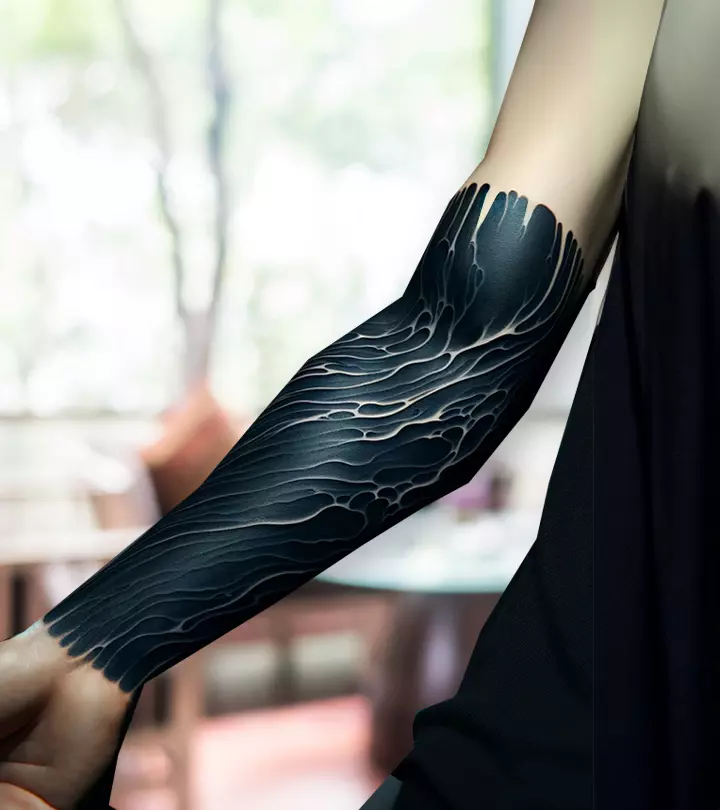White Tattoo On Dark Skin: Everything You Should Know
Find out how white tattoos on deep skin tones make way for captivating self-expression!

Image: Created with Dall·E
Getting a white tattoo on dark skin is a distinctive and intriguing trend that has popped up in the world of body art. As individuals seek unique ways to express themselves, the allure of white ink opens up an entirely different realm of possibilities for colorful tattoos as well. However, with the growing popularity of this ethereal ink, people are curious about its compatibility with various skin tones, from deeper complexions to pale skin. In this article, we will be addressing the intricacies of white tattoos on dark skin, and discussing its visual impact on deeper complexions. Whether you are a seasoned tattoo lover or a newcomer contemplating this delightful fusion, read on to discover the nuances and considerations regarding getting white tattoos on dark skin.
In This Article
What Are White Ink Tattoos?
Traditional black ink tattoos that are monochrome or even colorful designs, such as a floral tattoo, all employ darker hues for their shading and outlines. On the other hand, white ink tattoos employ a unique approach by using a subtle and translucent white-colored ink. This departure from the conventional black tattoos or colored inks creates a strikingly different aesthetic that is suitable for various skin types and skin tones. While the tattooing process is similar to that of regular tattoos, the visual impact of white ink designs is notable, especially on dark skin tones, like brown skin. The translucent nature of the white ink allows the skin’s natural color to shine through, resulting in a subtle yet captivating design with crisp clean lines. However, it is important to note that the healing process for white ink tattoos differs from regular ones, with the raised areas resembling scar tissue, adding an extra layer of complexity to this contemporary form of self-expression.

As is the case with color tattoos, visibility on the skin is a key factor of the design process, where some skin tones catch particular colors better. Hence, read on to learn how white ink tattoos appear on both dark skin and light skin tones.
White Ink Tattoos On Dark Skin Vs. Light Skin
The attraction to white ink tattoos lies in their unassuming appearance, but the visual impact can vary significantly depending on one’s skin tone.
For individuals with lighter skin tones, white ink tattoos may offer a discreet and understated aesthetic, blending seamlessly with the natural complexion for a subtle effect. However, it is necessary to be mindful of potential challenges, as white ink tattoos are known to fade relatively quickly, sometimes resembling prominent scars as they evolve over time.
On the other hand, the story unfolds quite differently for those with darker skin tones. The absorption of white ink may prove challenging, resulting in a less vibrant appearance. In fact, many tattoo artists caution against white ink tattoos on darker skin, as they have a tendency to fade completely after the healing process.
Dominique, a YouTuber, shared her experience with a white ink tattoo she got on her wrist, back in 2018. In her vlog, she says, “I don’t really think I have any more pictures after that point [3-ish weeks post tattooing] because it started to get difficult to take pictures of it as it was fading quickly. After about six months it had faded to the point where it wasn’t noticeable. It’s been two years or like a year and a half since I got the tattoo and right now I’m the only one that can see it (i).”
It is best to opt for a professional tattoo artist with experience working with white ink designs to align with your vision and understand your skin for the tattooing process. In the next section, we discuss how to find the right tattoo artist and get the best out of your inking adventure.
How To Find The Right Artist
Choosing the right tattoo artist is a pivotal step in the journey of getting inked, and it hinges on a few crucial factors, like the hygiene standards of the tattoo studio and the tattoo artist’s proficiency. Check below for some pointers for finding a competent tattoo artist.
- Check The Establishment’s Reputation
You should prioritize cleanliness and hygiene by choosing a reputable tattoo studio that adheres to stringent sanitization practices. Ensure that they openly discuss their sterilization methods for their instruments, needles, and inks and clear doubts for clients with queries.
- Read Reviews
Check public reviews of the tattoo parlor to gauge the experiences of others who have received tattoos there. Positive outcomes and a well-maintained environment are indicators of a trustworthy establishment and experienced artists.
- Go Through The Artist’s Portfolio
Carefully examine the artist’s portfolio, especially on social media platforms. Look for people with a diverse range of work that showcases their experience with different skin tones, including specific expertise in white ink tattoo designs.
- Ensure Specialization In Dark Skin Tattooing
If you have dark skin, prioritize working with an artist who specializes in tattooing a variety of dark skin tones. A skilled artist understands the nuances of how white ink interacts with diverse darker complexions.
- Check For Level Of Experience
Opt for a tattoo artist with extensive experience, as longevity in the profession often signifies expertise. Choosing an inexperienced artist can lead to issues with the tattoo colors or a lack of vibrant results, especially in the case of white ink tattoos.

Once you have found the right tattoo artist, it is essential to focus on the aftercare of your white ink tattoo. Scroll down to learn about the necessary steps to help it heal and keep it in good condition.
White Ink Tattoo: Aftercare
Caring for white ink tattoos requires consistent attention to ensure the longevity and vibrancy of the artwork. While the aftercare process shares similarities with that of traditional black tattoos, there are some specific considerations to keep in mind, which are as follows.
- Check For Potential Reactions And Keloid Scarring
White ink tattoos may pose a higher risk of reactions compared to black ink, with dark skin tones being more prone to keloid formation (an overgrowth of scar tissue/collagen leading to bumpy healed scars). Adjustments in tattooing techniques, such as reducing piercing power and avoiding excessive repetition, can minimize these risks.
- Monitoring The Healing Process And Hydration
After getting any tattoo, especially a white ink one, the healing process is crucial. It is essential to keep the tattooed area hydrated, and using a skin protectant is recommended. Avoid scratching the scabbing and healing the tattoo at all costs to prevent damage or infection.
- Providing Sunlight Protection
Protecting the tattoo from sunlight is extremely necessary, as exposure to UV rays can cause fading over time, especially for white ink which is already a lighter color. UV rays can break down the ink in the tattoo, making it essential to shield the tattooed area from direct sunlight.
- Maintaining Post-Healing Care
Once the initial healing phase is over, maintaining proper care by following the artist’s aftercare guidelines is crucial. Apply a gentle and non-comedogenic moisturizer or an unscented lotion to prevent the healed tattoo from feeling dry, and to ensure the longevity and vibrancy of the white ink tattoo.
- Recognizing Signs Of Infection
Monitoring the healing process is vital. If there is intense pain or raised tissue around the tattooed area, along with symptoms such as swelling, excessive bleeding or oozing, headaches, or fever, immediately seek medical attention.
- Cleaning And Treatment For Infection
In case of infection, it is recommended to clean the area gently with an antibacterial soap and warm water. However, seek medical advice if the symptoms persist or worsen.
Understanding the nuances of white ink tattoo aftercare ensures a healthy and vibrant outcome for this unique form of body art. In the next section, we cover one of the most commonly asked questions: How long does a white ink tattoo last on dark skin? Read on to learn more.
How Long Does A White Tattoo Ink Last On Dark Skin?
Determining the longevity of a white ink tattoo on dark skin involves a combination of individual factors, such as the healing process, and the quality of both the ink and the artist’s work. According to experts, the duration for which a white tattoo remains vibrant can vary based on the individual’s unique healing process, and the overall aftercare provided. Notably, on darker skin tones, the chances of complete fading are higher due to the darker pigmentation covering the light white pigment. It is possible to get touch ups to refresh the tattoo and retain its vibrancy. However, despite its tendency to initially create a 3D effect when healing, white ink is prone to faster fading compared to darker colors, and its luster will diminish over time.
The world of white ink tattoos is a fascinating intersection of artistry, individuality, and meticulous care. As is with any form of body art, the longevity of white ink tattoos on dark skin involves a blend of personal factors, healing processes, and the expertise of the artist. Whether you’re a seasoned tattoo enthusiast or a newcomer, white ink tattoos on dark skin demand an appreciation for the nuances involved in both the artistic process and aftercare. While challenges such as potential fading and the need for specialized aftercare and touch ups exist, embracing the journey as an informed individual and maintaining diligent care can contribute to a vibrant and unique result of self-expression.
Frequently Asked Questions
Do white tattoos take longer to heal?
No, the healing time for white tattoos is similar to other regular colors. The healing time for a tattoo primarily depends on factors such as the size of the tattoo, its placement, and how well it is cared for during the healing process. However, it’s essential to note that the healing process might be more noticeable with white ink tattoos due to the raised and scar-like appearance during initial healing.
What kind of tattoo looks good on dark skin?
Tattoos with bold and vibrant colors tend to look excellent on dark skin. Darker skin tones provide a rich canvas that can enhance the visual impact of colors like reds, blues, and greens, as well as intricate designs with strong contrasts.
Why is it harder to tattoo dark skin?
Tattooing dark skin can be more challenging because of the higher melanin levels. Melanin, responsible for skin pigmentation, can absorb the tattoo ink and make it challenging for certain colors, particularly lighter ones like white, to show up prominently.
Does white ink hurt more?
The level of pain experienced during a tattoo session is subjective and varies from person to person. However, there is no evidence to suggest that white ink tattoos inherently cause more pain than tattoos done with other ink colors. Pain perception depends on factors such as individual pain tolerance, the size and location of the tattoo, and the artist’s technique.
Key Takeaways
- White ink tattoos create a subtle and distinctive look on dark skin, but they fade must faster and appear scar-like during the healing process.
- Aftercare includes avoiding scratching, hydration, sunlight protection, and adherence to artist instructions to ensure vibrant and lasting white ink tattoos.
- The vibrancy duration of white ink tattoos varies based on individual factors such as pigmentation, healing, and ink quality.

Image: Stable Diffusion/StyleCraze Design Team
Curious about white ink tattoos and how they look on the skin? Check out this insightful video to learn the unique aspects of how white ink tattoos heal and find out how suitable it is for your next ink adventure!
Personal Experience: Source
StyleCraze's articles are interwoven with authentic personal narratives that provide depth and resonance to our content. Below are the sources of the personal accounts referenced in this article.
(i) My White Ink Tattoo 2 Year Update (With Pictures!)https://www.youtube.com/watch?v=9t_3RO81ulg
Read full bio of Madhumati Chowdhury
Read full bio of Joyce Joyson



























